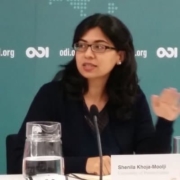Teachers are striking across America. From Arizona to Oklahoma to West Virginia, teachers are not simply demanding higher pay. They are also demanding better learning conditions for students and better working conditions for all state employees. And they are succeeding.
Many of these industrial workplace actions are taking place in states that have passed right-to-work laws, meaning workers cannot be compelled to join a union or pay union dues as a condition of employment. The strikes are also happening in the states that Trump won in 2016. So what does this mean for public education generally and the 2020 US presidential election?
My guest today is Eric Blanc, the author of the new book Red State Revolt: The Teachers’ Strike Wave and Working-Class Politics (Verso 2019). Eric is a journalist and a former high school teacher and has followed the on-the-ground developments of the Los Angeles, West Virginia, Oklahoma, Arizona, Denver, and Oakland public education strikes.
Citation: Blanc, Eric, interview with Will Brehm, FreshEd, 161, podcast audio, July 1, 2019. https://www.freshedpodcast.com/blanc/
Transcript, Translation, and Resources:
Will Brehm 1:41
Eric Blanc, Welcome to FreshEd.
Eric Blanc 1:43
Great. Thanks for having me on.
Will Brehm 1:45
So, on February 27, 2018, five days after protesting began, the president of the West Virginia Education Association, Dale Lee, announced to a crowd of teachers gathered outside the state capitol that the industrial action that they were undertaking was over. His words, though, weren’t actually received that well. So, can you describe this moment and what actually happened and what it meant to the protests in West Virginia?
Eric Blanc 2:14
Yeah, the moment you’re referring to is really one of the turning points and iconic moments of the whole strike wave in education since 2018. It’s basically when the West Virginia strike went “wildcat”, which is to say that the workers refused to go back to work despite both the state, all of the politicians, and their union leadership telling them to go back. But they refused because, in fact, they hadn’t won their demands yet and they were quite skeptical both of the powers that be and to be honest their union leadership, which had not been fighting in really systematic way for very long time. So, the workers ignored the dictate to go back, they continued to strike, and they ended up winning but it took another week. And that turning point really was the moment where the West Virginia strike started capturing the imagination of people across the country. And when it became clear that something new and very powerful was afoot.
Will Brehm 3:15
So, how did these strikes in West Virginia start? So, before talking about how they spread to other places, how on earth did they begin?
Eric Blanc 3:23
Well, the background, obviously, is that there’s been a really systematic push to dismantle public education in the United States both by republicans and democrats for years. And it got exacerbated in the wake of the economic crisis in 2008, where you have just really drastic budget cuts and austerity, which in turn furthers the push towards privatization and union busting across the board -not just in red states. So, there’s a backdrop of deteriorating conditions across the United States for educators. But I don’t think you can say that it was just conditions getting worse that automatically led to this type of rebellion because, frankly, conditions have been getting worse for educators for a very long time, without this type of response. And for other workers, many of whom were actually much worse off than educators. The deteriorating conditions hasn’t automatically led towards rebellion so, there’s more going on there. Part of the reason you see these strikes popping off now is that in education, unlike a lot of other workplaces, you do have a relatively solid number of organizers and radicals and progressives who are oriented towards trying to build a more progressive union and a more “fight back” labor movement. So, you had this crew of people in West Virginia, Arizona, Los Angeles, who realized that it was necessary to fight and who had a plan to start pushing in that direction. So, you know, this idea that the strikes were a spontaneous upsurge really underestimates the very serious and long organizing that took place to make them happen.
Will Brehm 5:10
So, there was a lot of history here of organizing and certain individuals that were mobilizing for perhaps quite a while. I mean, in your book, you mention one person who actually had experience in the 2012 Chicago protests. I mean, so it did go back quite a long time.
Eric Blanc 5:29
Yeah. In Arizona, Rebecca Garelli ended up becoming one of the key leaders of the Arizona strike and she, as you mentioned, had been a direct participant in the 2012 teachers strike in Chicago, which in some ways was really the first opening shot of what is now a national teacher’s rebellion. That really captured the imagination of folks across the country at the time, and set into motion the types of organizing, the types of social justice, radical unionism, that now we’ve seen really explode across the country.
Will Brehm 6:01
And was it just teachers going on strike in these schools and in the States, or were these strikes a much larger mobilization?
Eric Blanc 6:10
Yeah, no, definitely. These were not just teacher strikes contrary to what a lot of the mainstream media framed it as. The secret of success in the West Virginia strike in particular, but also elsewhere, was that it was an industrial strike, which is to say that it included all workers at a school site -not just teachers. Because, for those of you who might remember or who are educators, you can’t run a school just with teachers. You need the paraprofessionals, you need the secretaries, you need the custodians, you need the bus drivers, you need the cafeteria workers -where you have cafeterias still. And in West Virginia, the bus drivers in particular play this very crucial role both in making the strikes happen, and then having them continue when it went wildcat because in West Virginia, students really do depend on the buses to get to school because of the geography. There’s no way for them to get there without the buses. And when the bus drivers announced on the eve of the strike, and then midway through the strike, that no matter what else happened, even if the teachers were starting to waver, the buses weren’t going to run. That was this turning point, actually, in both of these really important moments in the strike. So yeah, it was very important that it wasn’t just a teacher strike and that it was really all education workers.
Will Brehm 7:27
Now, was the public behind these different strikes? I mean, I was in Oakland a few months ago, and I saw signs in store window front supporting the Oakland teachers who had recently been on strike. So, I mean, was there broad support from the general public for these teachers and other support staff?
Eric Blanc 7:49
Yeah, definitely. You know, it’s worth noting that -this might seem like a surprise, because for years, the establishment, both republicans and democrats, really demonized public sector workers. Framing the budget crisis and a lot of the various problems of the state in a given area as the fault of greedy public sector workers, and teachers were privileged, and that this problem in the schools was teachers. So, it’s not so obvious that parents would have come out in mass in support of a teacher strike. And a lot of educators were initially quite skeptical about doing something like a work stoppage. And they were worried about this narrative that they were hurting the students, right -by depriving them of an education, or not having a safe place for them to go- but because of the organizing that the educators and to a certain extent their unions did, to win over parents. Doing things like raising demands on behalf not just of educators, but on behalf of students, that went a really long way because you had teachers in place like Oklahoma, Arizona, or Los Angeles foregrounding, not the fight for pay but, in fact, the fight for more funding for students. In Los Angeles and Oakland as well fighting for more counselors and nurses. So, it made it much harder for the narrative of the politicians to gain traction, this idea that teachers were just fighting for themselves was clearly not the case, right. And because of that, the level of public support ended up being really astronomically high. We’re talking, on a national level, the polls have it in the high 70s of support for the teacher strikes and their demands. But even in the red states, you’re looking at very similar numbers: 75% in Arizona, 76% in Oklahoma. So yeah, these strikes were overwhelmingly supported by the population at large.
Will Brehm 9:45
And what were the teachers demanding?
Eric Blanc 9:47
Well, it varied state by state. Some of the commonalities were: there was certainly a lot of demands for better pay, there were demands for affordable health care in West Virginia. The West Virginia strike really centered around healthcare, not pay per se. One of the major demands in a lot of the states was for just increased funding for students. That the necessary services and school learning conditions just weren’t there to provide a decent education because schools have been systematically underfunded. So, there was a demand for just more per-pupil funding in a lot of states. And in places like Los Angeles, I think it went furthest on a certain type of social justice demand as far as anti-racism, they called for an end to racial profiling of black and Muslim students, called for the district to provide funds for immigrant families who are faced with deportation. All sorts of really important social justice demands that again, made it clear that this was not just about pay. It wasn’t just about educators, but it was really about improving the education and really life chances for working people and students as a whole.
Will Brehm 10:59
In the different states that you’ve studied, where these protests have happened in different states, would you say that the teacher strikes have been successful in achieving some of these demands?
Eric Blanc 11:08
Yeah, yeah, definitely. I mean, the overwhelming majority of the strikes have won. Much more than any other form of protest over these recent years. Educators had been protesting for quite a while and usually it took the form of just lobbying the Democratic Party, or, at best, showing up for like a yearly Lobby Day at the state legislature. So, these strikes have just shown in practice a much more effective way of fighting, which is to withhold your labor, create a crisis, and force the politicians or the employers to listen to you. And so yeah, in places like Arizona, you win a 20% pay raise for educators, which is unbelievable. West Virginia has won important wins as far as not just pay, but maintaining health care costs lower, defeating attempts to impose privatization, bring in charters. So, for the most part, the strikes have won, not just in beating back attacks, but in chipping away at the underfunding and underpay. That being said, the systematic improvements that public schools NEED haven’t been won. The strikes were a first step in that direction, but on the whole is still quite limited. So, there’s going to have to be a much more sustained movement, not just with strikes, but on the political level to bring about the funding, and the change in priorities of our society, to be honest, in order to really provide the schools that teachers are demanding.
Will Brehm 12:39
So, one of the things that is striking -no pun intended- about these strikes, is that they are taking place in “right to work” states, they are taking place in conservative states, so to speak, or for the large part. And so, it’s quite amazing to think that, you know, were these strikes actually illegal to begin with?
Eric Blanc 13:05
Yeah, so the first thing to say there is, in fact, public sector workers, in most states in the United States do not have the legal right to strike. There’s only 13 states in which public sector workers have the legal right to strike and elsewhere it’s basically illegal. So, that’s not just a red state phenomena. It’s not just a right to works phenomena. I live in New York, for instance, and public sector workers here do not have the right to strike. So, the challenge, therefore, is really much broader but it was put into particularly sharp relief in a place like Arizona, or West Virginia, where not only is there not a right to strike but the unions are much weaker, there’s not collective bargaining and you have a deeply entrenched Republican Party. So, it really came as a surprise to a lot of pundits and some activists as well because the perception amongst a lot of people in the United States is that red states are these deep bastions of conservatism, places that voted for Trump or presumably, just beyond the pale when it comes to trying to win people to progressive politics. And I think what the strikes showed, is, in fact, across the board, there is a working class looking for an alternative to the status-quo and when that alternative is provided, in the form of the teacher strikes, then even people who voted for Trump and you know, a lot of educators who struck and who are fighting against the republicans who took illegal action, they had voted for Trump. And so, it shows that there’s this latent reservoir of anger that can be channeled but it was not easy because as you mentioned, the strikes were illegal, so it took a lot of organizing, and a lot of time to build up people’s confidence so that they could defy the republicans who are threatening to fire people if they struck. So, I do think that one of the big lessons of the strike wave is: if labor is going to revive, it’s going to mean breaking the law in a lot of cases and you can do that and win if you have enough people on your side. And that was really what the organizers kept on saying, they said, “Look, if we all go out, what are they going to do, fire us all?” And in fact, yeah, when they did strike, they broke the law, but they had so much support and they had such a deep level of organization and mobilization that the republicans basically had their bluff called on them because they realized that if they tried to repress a movement like that it probably would have backfired. It would have made it even deeper because people would have been so incensed that they were jailing or firing teachers just fighting for better funding for students. It just wouldn’t have resolved anything.
Will Brehm 15:56
So how did they mobilize then? I mean, if the strikes were illegal, I would imagine going through the typical union channels might not have been possible? The rank and file had to organize sort of amongst themselves. So how did they do that without, in a way causing too much attention in the beginning? I would imagine it must have been a delicate process.
Eric Blanc 16:20
Yeah, well, part of the dynamic in these red states was that the strikes were overwhelmingly initiated and really led by the rank and file. The unions in these states, like elsewhere, were wholly oriented towards just lobbying the democrats and were pretty stubbornly resistant at first against the idea that started spreading about, well, maybe we should strike to stop these attacks where they already existed, or to fight for better conditions. And it was really rank and file activists, oftentimes socialists, who formed Facebook groups of all things that started uniting these different teachers and educators across the state to discuss with each other, to share information, to share memes, to get each other riled up, to kind of get a sense that actually something was growing and to build momentum. And it was through these Facebook pages, although you know, I don’t want to exaggerate the role of social media, there was also a lot of serious organizing in the workplaces, a lot of traditional organizing methods done by these organizers even if the unions weren’t fully on board. They did systematically try to do one on one meetings at workplaces, get people to wear red on the same day to build up kind of a collective momentum and it was these types of organizing on the ground combined with social media and Facebook groups in particular, that were able to create enough of a groundswell that eventually, in West Virginia, the union was pushed towards supporting the strike. And similarly, that was the dynamic in Arizona and Oklahoma and these other states as well, where there was a rank and file insurgency and for the most part, the unions eventually got on board -under considerable pressure though.
Will Brehm 18:20
So, when you look across at West Virginia, Oklahoma, and Arizona, what would you say are the biggest differences in how these different strikes came about?
Eric Blanc 18:31
You know, there’s a lot of different history traditions in each of the states. So, one of the aspects of the West Virginia strike, which was real, although somewhat exaggerated, was that West Virginia has a strong labor tradition. You know, the history of the mine wars and the coal miner militancy, as well as the more recent teacher strike in 1990, did play a role in, I think, explaining why the West Virginia strike was the first in 2018, and why things popped off there. Because there was a level of accumulated militancy and labor movement “know-how” that made it possible to get the ball rolling. That being said, the real, main difference that I try to highlight in the book, that it can explain why the strikes developed much more successfully in West Virginia, and Arizona, and less so in Oklahoma, was that in both West Virginia, and Arizona, you had what I call militant minority, which is to say, you had a leadership of workplace organizers who knew how to organize, who had been organizing for a while, and who had an orientation towards building towards a strike and towards class struggle politics generally, and you didn’t have a similar layer like that in Oklahoma. And if you look at Arizona, which I try to go into a lot of detail about because it’s a little bit less known as a strike and it also puts in the sharpest relief the importance of this layer of organizers, often radicals, often socialist because in Arizona there was no living labor tradition in contrast with West Virginia, for instance. So, you can’t really explain the success of the Arizona strike, in the absence of really foregrounding this amazingly dynamic leadership layer that was able to draw on the lessons from the Chicago strike from West Virginia and build up systematic power and organization and win. And in Oklahoma, you didn’t have an equivalent leadership group and so they much more relied on social media, they did a lot of tactical errors, there was not really any systematic organizing on the ground, and that’s one of the main reasons why their strike was significantly less successful. So the big lesson I draw there in the book on this question, at least is, it does highlight the need for the left and you know, which historically has played a key role in leading labor movements to reorient towards workplace organizing, towards union organizing, so that in the struggles to come we can play a similar role as West Virginia, or Arizona and avoid sort of the missed opportunities like we saw in Oklahoma.
Will Brehm 21:06
One of the things that I was quite amazed about in your book was when you talked about how some of the teachers that were involved in the strikes were heavily influenced by Bernie Sanders, or at least the 2016 Bernie Sanders campaign. Can you talk a little bit about how that campaign influenced, two years later, the strikes in West Virginia, and Arizona, and Oklahoma?
Eric Blanc 21:29
Yeah, well, again, I think the big story here is it shows that this red state vs blue state narrative is very superficial because Bernie played a huge role in West Virginia and Arizona because he legitimized, in 2015 and 2016, a basic class politics that has continued to reverberate up until the present. And that took the form of the strikes in a different iteration. So, one of the really surprising aspects of the strike wave that I discovered when I was on the ground was a lot of these core organizers in West Virginia, Arizona, the people that initiated the strikes, first got organized together through the Bernie campaign in West Virginia, for instance, Jay O’Neal and Emily Comer who really initiated and began the strike organizing in the summer of 2017, were members of the Democratic Socialists of America and had organized a study group with each other in the summer of 2017, around Jane McAlevey’s book, No Shortcuts. But it was in the context then, after the Bernie Sanders campaign that they had gotten together. And similarly, in Arizona, the key organizers, you know, someone like Dylan Wegela who was one of the central leaders, the first organizing he’d ever done was a keg party at his college to raise funds for Bernie in 2015. So, these are relatively younger teachers who got inspired by Bernie’s message of taking on the billionaires, who are sick of the politics as usual, both of the republicans but again, of this kind of failed orientation towards just hoping the mainstream of the Democratic Party was going to deliver anything and they pushed in a much more radical direction. And it’s a sign of the times then that both socialists Bernie supporters were seen as legitimate leaders despite the red baiting that happened, and you had Trump voting teachers siding openly with their socialist leadership of the strike against Republican politicians and so, you can only explain that in the context of a pretty deep alienation from the status-quo amongst millions of working people, and the revival of a socialist movement after the Bernie campaign.
Will Brehm 23:50
And so, what’s happening today in West Virginia? I mean, I look at my Twitter feed, and I read the news and the teachers are still protesting. There’s still collective action that is happening. So, can you bring us up to date since at least from the end of your book to today, what on earth is going on in West Virginia?
Eric Blanc 24:09
Right. So, the powers that be really got whomped in 2018. The strikes caught them by surprise and they just kind of lost across the board. But they aren’t stupid, and they realized how much of a threat this new movement is to them. So, they’ve done everything now to recohere themselves and to try to systematically beat back the gains that were won and to try to defeat the teachers, basically. And in West Virginia, where it really started, that has been very much an ongoing battle. And so earlier this spring, the teachers and education workers in West Virginia struck again, because the republicans tried to, again, impose a really Draconian policy of this time imposing charter schools and privatization in the state, penalizing striking even further. And in the spring, educators went on strike and defeated that in another statewide illegal strike that didn’t quite get as much national attention but in some ways was just as powerful a strike as the year before. But again, as you mentioned, just as we speak, the republicans again, even just a few months after having been defeated on this, are relentlessly trying to bring back the exact same bill. And their hope is, now that it’s summertime, and that schools aren’t in session, they’ll be able to impose this because educators can’t strike because schools are closed. So, the dynamic is very challenging. Fortunately, the public support is overwhelmingly on the side of educators. The state, led by the republicans, actually did town halls on the question of privatization and charters, and 88% of the people that participated were against what the republicans were proposing. So, it’s just clear that this is a minority view backed by out of state corporations that is just trying to smash the teachers and public education. But it remains to be seen whether they’ll be able to get away with it because it’s summertime. Luckily, the teachers are mobilized, they’re going to the capitol, they’ve created enough fissures that some of the politicians, including the governor now is talking about potentially vetoing or opposing this bill. So, there’s definitely movement is continuing to generate enough power to be able to potentially win and we’ll just have to keep our eyes on what’s going on and hopefully keep on supporting them. Because the national support really is a big part of the story. For any of the education workers who have gone on strike, having a sense that people across the country and really across the world have their back has been a really important factor for giving them the energy to keep on fighting in what often feels like, at this point, an endless battle, right. Just the republicans just and oftentimes the democrats just won’t give up in trying to push through these really reactionary policies.
Will Brehm 27:12
Yeah, I mean, I do think of someone like Cory Booker, who ends up going to all these charter school conferences. He gets paid to give keynotes and a lot of other Democratic candidates are pro-charter school, for instance. So, I guess, what then does this all mean for the 2020 election? You know, all this mobilization around teachers over the last few years, what do you see the impact on the 2020 election?
Eric Blanc 27:38
Yeah, that’s a great question. I think there’s a few different ways you can look at this. The first is, if you really understand what happened in the red state strikes, you see the potential and the need to project a sharp working class politics. So rather than trying to tack to the center, as someone like Biden, Hillary did in 2016, that’s actually a losing strategy because what’s going to motivate people to get you on board, and to really get excited about a campaign and turn out to vote is not the same old status-quo but is a clear vision for change that is independent of the establishment. And so, the strikes represented that potentiality and I think that the candidacy of someone like Bernie Sanders is really the best electoral expression of that same type of politics. In the same way it already helped build the strike wave, now it can continue to be an expression of and in turn a boost for education militancy. So, you know, the Sanders campaign has been actively using its lists to tell people to show up for picket lines. And there’s a big movement growing now a Labor for Bernie, an Educators for Bernie, in which there’s a push within the teacher’s unions to call on their union leaderships to allow the members to vote on who the union should endorse in 2020. Because last time in 2015, 2016, the big education unions, and these are the biggest unions in the country, rammed through in a really unilateral, anti-democratic fashion: a Hillary endorsement. And so there’s a rank and file upsurge -now many of whom people participated in the strikes, calling for a democratic vote, and push hopefully, through that democratic vote, to have the unions endorse Bernie, and to use that to build the movement and to defeat Trump and to build the schools that we need, because the issue of public education is central, people support it across the board, but unfortunately, the mainstream of the Democratic Party still remains quite tied to the corporations that want to systematically underfund education. And there’s more rhetoric now around supporting teachers but there’s not much reason to suspect that the mainstream establishment is really going to be committed to bringing about the changes that our schools need.
Will Brehm 30:07
Well, Eric Blanc, thank you so much for joining FreshEd, we’re going to have to keep our eyes on West Virginia and Arizona and other states over the next few years and into 2020 for certain. So, thank you again for joining. It really was a pleasure of talking today.
Eric Blanc 30:21
Thanks for having me on.
Red State Revolt










